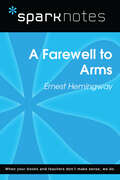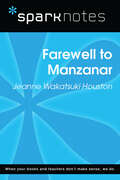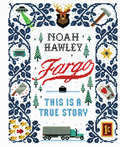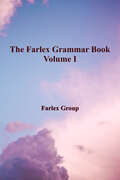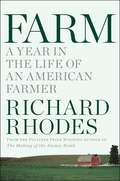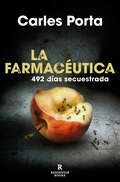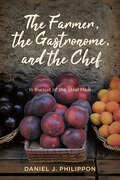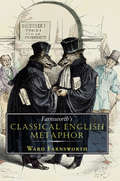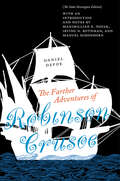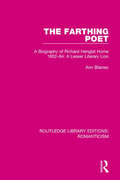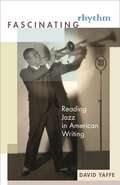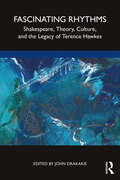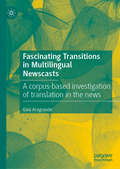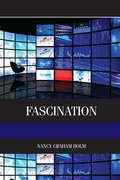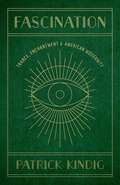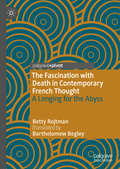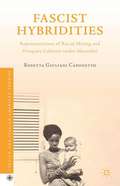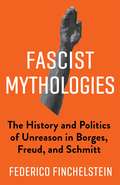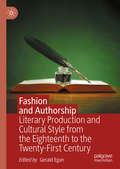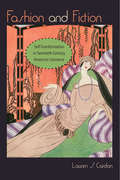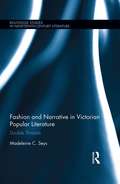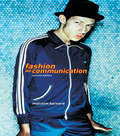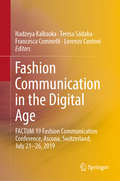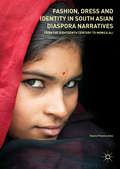- Table View
- List View
A Farewell to Arms (SparkNotes Literature Guide Series)
by SparkNotesA Farewell to Arms (SparkNotes Literature Guide) by Ernest Hemingway Making the reading experience fun! Created by Harvard students for students everywhere, SparkNotes is a new breed of study guide: smarter, better, faster.Geared to what today's students need to know, SparkNotes provides:chapter-by-chapter analysis explanations of key themes, motifs, and symbols a review quiz and essay topics Lively and accessible, these guides are perfect for late-night studying and writing papers.
Farewell to Manzanar (SparkNotes Literature Guide Series)
by SparkNotesFarewell to Manzanar (SparkNotes Literature Guide) by Jeanne Wakatsuki Houston Making the reading experience fun! Created by Harvard students for students everywhere, SparkNotes is a new breed of study guide: smarter, better, faster.Geared to what today's students need to know, SparkNotes provides:chapter-by-chapter analysis explanations of key themes, motifs, and symbols a review quiz and essay topics Lively and accessible, these guides are perfect for late-night studying and writing papers.
Fargo: This Is a True Story
by Noah HawleyThe making of the acclaimed, award-winning TV show told exactly as it occurred.From bestselling, Edgar Award-winning author Noah Hawley (Before the Fall) comes the perfect collector's item to the hit TV show based on the film Fargo. This companion to the first three seasons of Fargo, which Hawley created and executive produced, is packed with script selections-including all three pilots-candid, behind-the-scenes photography, exclusive interviews with cast and crew, and much, much more.Learn about what makes Lorne Malvo tick in a fascinating conversation with Billy Bob Thornton. Discover Kirsten Dunst's and Jesse Plemons's favorite scenes. Find out what it was like for Ewan McGregor to play both Stussy brothers. Hear from Patrick Wilson, Carrie Coon, Mary Elizabeth Winstead, and many others as Hawley, in this gorgeous, illuminating journey, takes you behind the curtain to reveal the making of one of the best shows on television.
The Farlex Grammar Book Volume I Complete English Grammar Rules: Examples, Exceptions, Exercises, and Everything You Need to Master Proper Grammar (The\farlex Grammar Book Ser.)
by Farlex InternationalFarlex brings you the most comprehensive grammar guide yet: all the rules of English grammar, explained in simple, easy-to-understand terms. Over 500 pages of proper grammar instruction—2X more than the leading grammar book! Whether you're an expert or a beginner, there's always something new to learn when it comes to the always-evolving English language. Don't rely on multiple incomplete textbooks that contradict each other—fill in all the gaps in your grammar knowledge with one go-to guide. Only this book gives you key exceptions, common grammar mistakes, thousands of real-world examples, and hundreds of grammar quizzes designed to help you retain what you've learned. With this book, you'll be able to: Quickly master basic English grammar and tackle more advanced topics. Properly use every type of noun, verb, and even the most obscure grammar elements. Master verb tenses, including irregular verbs and exceptions. Avoid embarrassing grammar errors. Immediately put your skills into action! Become a more effective writer and communicator in school, at work, and in everyday conversation.
Farm
by Richard RhodesPulitzer Prize winning author, Richard Rhodes's year-long journey into the heart of American agriculture reveals a life trapped between two eras: the modern and the traditional, the future and the past.Richly textured and deeply moving, Farm chronicles a year in the life of Tom and Sally Bauer of Crevecoeur County, Missouri, who cultivate nearly two square miles of the surface of the earth. They struggle to build up their farm, harvesting corn, birthing calves, planting wheat, coping with the vagaries of nature and government regulations. Required of them are ancient skills (an attunement to the weather, animals, crops, and land) as well as a mastery of modern technology, from high-tech machinery to genetics and sophisticated chemicals. Written with honesty and insight, Farm is a revelatory exploration of farm life in the 20th century and the joys and challenges of the modern rural landscape.
La farmacéutica: 492 días secuestrada
by Carles PortaHas oído hablar de esta historia, pero ni la conoces entera ni te la han contado nunca así. *****INCREÍBLEMENTE REAL***** «El 20 de noviembre de 1992 secuestraron a Maria Àngels Feliu Bassols, farmacéutica de Olot. Esta mujer, madre de tres hijos, pasó dieciséis meses bajo tierra, enterrada viva en un agujero del tamaño de un armario. Arañas, hormigas, ratas, serpientes y humedad fueron sus compañeras de cautiverio.» Así empieza la historia increíblemente real de uno de los casos más extremos de la crónica negra española. Aquel crimen se transformó en un drama humano cuya investigación, repleta de errores policiales y judiciales, estuvo acompañada de vergonzosos ejemplos de periodismo basura. Por si fuera poco, los captores de Maria Àngels se mostraron incapaces de culminar el secuestro exprés que habían planeado. Lo único que lograron fue eternizar el suplicio de una mujer que sobrevivió a tan adversas circunstancias gracias a su determinación y su fortaleza psíquica. Tras ser liberada, aún tuvieron que transcurrir cinco años para que los responsables fueran detenidos y otros cuatro para juzgarlos. Después de revisar a fondo la información generada por el suceso, Carles Porta ha reconstruido el caso al completo, en un único hilo narrativo. No existe otra recreación tan rigurosa de todas las historias entrecruzadas que rodearon el secuestro de la farmacéutica de Olot. Sin duda, con este libro Porta se consagra como uno de los maestros del periodismo narrativo de nuestro país. La crítica ha dicho sobre Tor, la montaña maldita:«Truman Capote, James Ellroy o Emmanuel Carrère han demostrado que se puede hacer gran literatura utilizando tan solo los datos reales de un crimen, por archiconocido que este sea. Por estas tierras, Carles Porta ya lo dejó claro con Tor, la montaña maldita.»Xavi Ayén, La Vanguardia «Un excelente trabajo periodístico.»María José Obiol, Babelia «Se lee como una muy buena novela.»Kiko Amat, Cultura/s Sobre Fago. Si te dicen que tu hermano es un asesino:«Un libro fantástico y emocionante, [...] digno representante del periodismo literario.»Óscar López, Página Dos «Su calidad literaria es inapelable. [...] Una obra profunda y poderosa.»Pere Antoni Pons, Ara Sobre Le llamaban padre:«Periodismo en profundidad, y próximo. Una gran investigación.»Ignacio Orovio, La Vanguardia
The Farmer, the Gastronome, and the Chef: In Pursuit of the Ideal Meal
by Daniel J. PhilipponThe role of food writing in the sustainable food movement At turns heartfelt and witty, accessible and engaging, The Farmer, the Gastronome, and the Chef explores how Wendell Berry, Carlo Petrini, and Alice Waters have changed America&’s relationship with food over the past fifty years. Daniel Philippon weighs the legacy of each of these writers and activists while planting and harvesting vegetables in central Wisconsin, speaking with growers and food producers in northern Italy, and visiting with chefs and restaurateurs in southeastern France. Following Berry, Petrini, and Waters in pursuit of his own &“ideal meal,&” Philippon considers what a sustainable food system might look like and what role writing can play in making it a reality. Warning of the dangers of &“agristalgia,&” Philippon instead advocates for a diverse set of practices he calls &“elemental cooking,&” which would define sustainable food from farm to table, while also acknowledging the importance of seeking social justice throughout the food system. A rigorous yet generous appraisal of three central figures in the sustainable food movement, The Farmer, the Gastronome, and the Chef demonstrates how the written word has the power to change our world for the better, one ideal meal at a time.
The Farmers (Fountas & Pinnell LLI Green #Level A, Lesson 24)
by Alex GomezFountas and Pinnell Leveled Literacy Intervention Green System -- 1st Grade
Farnsworth's Classical English Metaphor
by Ward FarnsworthFarnsworth's Classical English Rhetoric was the definitive guide to the use of rhetorical devices in English. It became a best-seller in its field, with over 20,000 copies in print. Here now is the natural sequel, Farnsworth's Classical English Metaphor--the most entertaining and instructive book ever written about the art of comparison. A metaphor compares two things that seem unalike. Lincoln was a master of the art (A house divided against itself cannot stand). So were Jefferson (The tree of liberty must be refreshed from time to time with the blood of patriots and tyrants) and Shakespeare (All the world's a stage/And all the men and women merely players). Farnsworth's book is the finest collection of such figurative comparisons ever assembled. It offers an original analysis of patterns in the sources and uses of metaphor. It also explains the different stylistic ways that comparisons can be written, and with what effects. The book starts by dividing the sources of metaphor into families, including nature, architecture, animals, and myth. It then shows how the best writers have put each of those traditions to distinctive use-for the sake of caricature, to make an abstract idea visible, to make a complicated idea simple. The book provides, along the way, an extraordinarily wide-ranging tour of examples from novelists, playwrights, philosophers, and orators. There is interest, instruction, and amusement to be found on every page. Ward Farnsworth-lawyer, dean, teacher, and polymath-has produced another indispensable book for the writer. Classical English Metaphor will be a constant source of learning and enjoyment for anyone who appreciates the art of observation and the pleasure of well-chosen words.
The Farther Adventures of Robinson Crusoe: The Stoke Newington Edition
by Daniel Defoe DefoeDefoe’s The Farther Adventures of Robinson Crusoe was almost always published together with The Life and Strange Surprizing Adventures of Robinson Crusoe. Only after 1950 was the first volume printed alone—a shorter work for some classes. But in addition to fulfilling the promise of the first volume, The Farther Adventures is an exciting adventure novel by itself. Crusoe returns to his island to learn about his colony, and then travels to Madagascar, India, and China before returning to England after some exciting encounters. Complete with an introduction, line notes, and full bibliographical notes, this is an edition like no other. Published by Bucknell University Press. Distributed worldwide by Rutgers University Press.
The Farthing Poet: A Biography of Richard Hengist Horne 1802-84: A Lesser Literary Lion (Routledge Library Editions: Romanticism #5)
by Ann BlaineyFirst published in 1968. Richard Hengist Horne, virtually unknown today, was one of the more extraordinary figures of the nineteenth century literary scene. The author of an epic poem Orion was acclaimed a work of genius by almost every English critic. His voluminous literary output is for the most part forgotten, but his life and character, his widely romantic aspirations to be a Man of Genius, provide a fascinating tragi-comic study. As a background study to the literature and society of the time, Ann Blainey’s book is packed with interest and anecdote, and as a study of a remarkable man it is consistently entertaining.
Fascinating Rhythm: Reading Jazz in American Writing
by David YaffeHow have American writers written about jazz, and how has jazz influenced American literature? In Fascinating Rhythm, David Yaffe explores the relationship and interplay between jazz and literature, looking at jazz musicians and the themes literature has garnered from them by appropriating the style, tones, and innovations of jazz, and demonstrating that the poetics of jazz has both been assimilated into, and deeply affected, the development of twentieth-century American literature. Yaffe explores how Jewish novelists such as Norman Mailer, J. D. Salinger, and Philip Roth engaged issues of racial, ethnic, and American authenticity by way of jazz; how Ralph Ellison's descriptions of Louis Armstrong led to a "neoconservative" movement in contemporary jazz; how poets such as Wallace Stevens, Hart Crane, Langston Hughes, and Frank O'Hara were variously inspired by the music; and how memoirs by Billie Holiday, Charles Mingus, and Miles Davis both reinforced and redeemed the red light origins of jazz. The book confronts the current jazz discourse and shows how poets and novelists can be placed in it--often with problematic results. Fascinating Rhythm stops to listen for the music, demonstrating how jazz continues to speak for the American writer.
Fascinating Rhythms: Shakespeare, Theory, Culture, and the Legacy of Terence Hawkes
by John DrakakisAs one of the most adventurous literary and cultural critics of his generation, Terence Hawkes’ contributions to the study of Shakespeare and the development of literary and cultural theory have been immense. His work has been instrumental in effecting a radical shift in the study of Shakespeare and of literary studies. This collection of essays by some of his closest colleagues, friends, peers, and mentees begins with an introduction by John Drakakis, outlining the profound impact that Hawkes’ work had on various areas of literary studies. It also includes a poem by Christopher Norris, who worked with Hawkes for many years at the University of Cardiff, as well as work on translation, social class, the historicist and presentist exploration of Shakespearean texts, and teaching Shakespeare in prisons. The volume features essays by former students who have gone on to establish reputations in areas beyond the study of literature, and who have contributed ground-breaking volumes to the pioneering New Accents series. It concludes with Malcolm Evans’ innovative account of the migration of semiotics into the area of business. This book is a vibrant and informative read for anyone interested in Hawkes’ unique blend of literary and cultural theory, criticism, Shakespeare studies, and presentism.
Fascinating Transitions in Multilingual Newscasts: A corpus-based investigation of translation in the news
by Gaia AragrandeThis book combines methods including Critical Discourse Analysis (CDA), Corpus Linguistics and comparative analysis in order to grasp the complexities and ramifications of multilingual broadcasting journalism in different national and supranational contexts. Starting with the idea that both journalism and translation are multi-layered objects and may conceal power dynamics and struggles within society, the author uses a theoretical and methodological convergence framework to analyse examples from Italy, the UK and Europe, as well as calling for larger and more systematic studies about language transfer activities in the news. This book will be of interest to students and scholars of translation, corpus linguistics, journalism and CDA.
Fascination: Viewer Friendly TV Journalism
by Nancy Graham HolmDeveloped from the established traditions of print and radio journalism, television journalism has often failed to reach its potential to develop away from these other media. However, because of the synthesis of words, pictures, and sound, television journalism has the ability to shift from simply reporting the news to weaving stories. In Fascination, veteran television journalist Nancy Graham Holm incorporates years in the field and extensive teaching experience to produce an instructive and entertaining guide to all aspects of television journalism. With a dual focus on aesthetics and technique, this book instructs the reader on the best way to use visuals and sound, different reporting techniques, and appropriate behaviour for journalists. Each chapter benefits from real-world examples and helpful tips to guide the reader through each stage of television journalism. This book is an excellent guide for those wanting to start a career in television journalism as well as seasoned professionals wishing to gain a new perspective.
Fascination: Trance, Enchantment, and American Modernity
by Patrick KindigMost cultural critics theorize modernity as a state of disenchanted distraction, one linked to both the rationalizing impulses of scientific and technological innovation and the kind of dispersed, fragmented attention that characterizes the experience of mass culture. Patrick Kindig’s Fascination, however, tells a different story, showing that many fin-de-siècle Americans were in fact concerned about (and intrigued by) the modern world’s ability to attract and fix attention in quasi-supernatural ways. Rather than being distracting, modern life in their view had an almost magical capacity to capture attention and overwhelm rational thought.Fascination argues that, in response to the dramatic scientific and cultural changes of the late nineteenth and early twentieth centuries, many American thinkers and writers came to conceive of the modern world as fundamentally fascinating. Describing such diverse phenomena as the electric generator, the movements of actresses, and ethnographic cinema as supernaturally alluring, they used the language of fascination to process and critique both popular ideologies of historical progress and the racializing logic upon which these ideologies were built. Drawing on an archive of primary texts from the fields of medicine, (para)psychology, philosophy, cultural criticism, and anthropology—as well as creative texts by Harriet Prescott Spofford, Charles Chesnutt, Theodore Dreiser, Paul Laurence Dunbar, Edward S. Curtis, Robert J. Flaherty, and Djuna Barnes—Kindig reconsiders what it meant for Americans to be (and to be called) modern at the turn of the twentieth century.
The Fascination with Death in Contemporary French Thought: A Longing for the Abyss
by Betty RojtmanThis book analyses a cultural phenomenon that goes to the very roots of Western civilization: the centrality of death in our sense of human existence. It does so through a close reading of seminal works by the most creative authors of modern French thought, such as Maurice Blanchot, Jacques Lacan, and Jacques Derrida. These works encode an entire ethics of postmodernism. Betty Rojtman offers the reader a prism through which to see anew the key issues of the twentieth century: tragedy, finitude, nothingness—but also contestation, liberty, and sovereignty. Little by little we understand that this fascination with death may be just the other side of humankind’s great protest, its thirst for the infinite and its desire to be. Finally, Rojtman tries to offer another view on these fundamental questions by shifting to a parallel cultural reference: Kabbalah.
Fascist Hybridities
by Rosetta Giuliani CaponettoWhile less explicitly racist than its Germany Nazi counterpart, Italian Fascism attached considerable importance to racial purity. Fascist Hybridities examines how Italian literature and cinema of the 1930s are traversed by hybrid figures, and how these works ultimately reveal biracial offspring and Levantines as interchangeable characters who, in the historical scenario under which Mussolini’s Fascist regime operated, present unique and specific threats to notions of Italian racial and cultural purity. As Rosetta Giuliani-Caponetto shows, that more often than not, the visual and textual presence of mulatto and Levantine characters stoked deep racial and cultural anxieties, forcing their audiences to uncomfortably examine, rather than confirm, their own collective identity.
Fascist Mythologies: The History and Politics of Unreason in Borges, Freud, and Schmitt (New Directions in Critical Theory #79)
by Federico FinchelsteinFor fascism, myth was reality—or was realer than the real. Fascist notions of the leader, the nation, power, and violence were steeped in mythic imagery and the fantasy of transcending history. A mythologized primordial past would inspire the heroic overthrow of a debased present to achieve a violently redeemed future. What is distinctive about fascist mythology, and how does this aspect of fascism help explain its perils in the past and present?Federico Finchelstein draws on a striking combination of thinkers—Jorge Luis Borges, Sigmund Freud, and Carl Schmitt—to consider fascism as a form of political mythmaking. He shows that Borges’s literary and critical work and Freud’s psychoanalytic writing both emphasize the mythical and unconscious dimensions of fascist politics. Finchelstein considers their ideas of the self, violence, and the sacred as well as the relationship between the victims of fascist violence and the ideological myths of its perpetrators. He draws on Freud and Borges to analyze the work of a variety of Latin American and European fascist intellectuals, with particular attention to Schmitt’s political theology. Contrasting their approaches to the logic of unreason, Finchelstein probes the limits of the dichotomy between myth and reason and shows the centrality of this opposition to understanding the ideology of fascism.At a moment when forces redolent of fascism cast a shadow over world affairs, this book provides a timely historical and critical analysis of the dangers of myth in modern politics.
Fashion and Authorship: Literary Production and Cultural Style from the Eighteenth to the Twenty-First Century (Palgrave Studies In The Enlightenment, Romanticism And Cultures Of Print Ser.)
by Gerald EganStudies of fashion and literature in recent decades have focused primarily onrepresentations of clothing and dress within literary texts. But what about theauthor? How did he dress? What where her shopping practices and predilections?What were his alliances with modishness, stylishness, fashion? The essays in thisbook explore these and other questions as they look at authors from theeighteenth century through the postmodern and digital eras, cultural producerswho were also men and women of fashion: Alexander Pope, Hester Thrale, MaryRobinson, Lord Byron, William Thackeray, Charlotte Bronte, Wilkie Collins,Margaret Oliphant, Virginia Woolf, Rebecca West, Trudi Kanter, Angela Carter,and Martin Margiela. The essays collected here ultimately converge upon afundamental question: what happens to our notions of timeless literature whenauthorship itself is implicated in the transient and the temporary, the cycles andmaterials of fashion?“Gerald Egan’s provocative introduction to this exciting new book poses a boldquestion: How are authorship and literature – so often linked to ideas oftranscendence – implicated in the transient trends and stuff of fashion? Thethirteen chapters that follow track authorship’s complex implication in thediscourses and materiality of fashion and fashionable goods from the eighteenthto the twentieth centuries. Wide-ranging in discipline and chronology, yetforensically focused and carefully argued, this book makes a striking andwonderfully original contribution to studies of authorship, celebrity and materialculture.”— Dr Jennie Batchelor, Professor of Eighteenth-Century Studies,University of Kent, UK
Fashion and Fiction: Self-Transformation in Twentieth-Century American Literature (Cultural Frames, Framing Culture)
by Lauren S. CardonDuring the twentieth century, the rise of the concept of Americanization--shedding ethnic origins and signs of "otherness" to embrace a constructed American identity--was accompanied by a rhetoric of personal transformation that would ultimately characterize the American Dream. The theme of self-transformation has remained a central cultural narrative in American literary, political, and sociological texts ranging from Jamestown narratives to immigrant memoirs, from slave narratives to Gone with the Wind, and from the rags-to-riches stories of Horatio Alger to the writings of Barack Obama. Such rhetoric feeds American myths of progress, upward mobility, and personal reinvention. In Fashion and Fiction, Lauren S. Cardon draws a correlation between the American fashion industry and early twentieth-century literature. As American fashion diverged from a class-conscious industry governed by Parisian designers to become more commercial and democratic, she argues, fashion designers and journalists began appropriating the same themes of self-transformation to market new fashion trends. Cardon illustrates how canonical twentieth-century American writers, including Edith Wharton, Theodore Dreiser, F. Scott Fitzgerald, Ernest Hemingway, and Nella Larsen, symbolically used clothing to develop their characters and their narrative of upward mobility. As the industry evolved, Cardon shows, the characters in these texts increasingly enjoyed opportunities for individual expression and identity construction, allowing for temporary performances that offered not escapism but a testing of alternate identities in a quest for self-discovery.
Fashion and Narrative in Victorian Popular Literature: Double Threads (Routledge Studies in Nineteenth Century Literature)
by Madeleine C. SeysWe know that way we dress says a lot about us. It’s drilled into us by our parents as children, as adults throughout our working lives, and eternally from the culture surrounding us. Our dress tells the outside world of the culture and era we come from to our social status within that culture. Our dress can be telling of our political views, religious beliefs, sexuality and countless other identifying traits that we can keep hidden or show to the world by our choice of what to wear when heading venturing out. This was absolutely true, famously so, in the Victorian Era in which men and women alike wore their status on their often lavish, embellished sleeves. In her new book, Dr. Madeleine Seyes explores Victorian culture through the lens of fashion in her new book, Double Threads: Fashion and Victorian Popular Literature, which sits at the intersection of the fields of Victorian literary studies, dress and material cultural studies, feminist literary criticism, and gender and sexuality studies.
Fashion as Communication
by Malcolm BarnardWhat kinds of things do fashion and clothing say about us? What does it mean to wear Gap or Gaultier, Milletts or Moschino? Are there any real differences between Hip-Hop style and Punk anti-styles? In this fully revised and updated edition, Malcolm Barnard introduces fashion and clothing as ways of communicating and challenging class, gender, sexual and social identities.Drawing on a range of theoretical approaches from Barthes and Baudrillard to Marxist, psychoanalytic and feminist theory, Barnard addresses the ambivalent status of fashion in contemporary culture.
Fashion Communication in the Digital Age: FACTUM 19 Fashion Communication Conference, Ascona, Switzerland, July 21-26, 2019
by Nadzeya Kalbaska Teresa Sádaba Francesca Cominelli Lorenzo CantoniThis book represents a major milestone in the endeavour to understand how communication is impacting on the fashion industry and on societal fashion-related practices and values in the digital age. It presents the proceedings of FACTUM 19, the first in a series of fashion communication conferences that highlights important theoretical and empirical work in the field. Beyond documenting the latest scientific insights, the book is intended to foster the sharing of methodological approaches, expand the dialogue between communications’ studies and fashion-related disciplines, help establish an international and interdisciplinary network of scholars, and offer encouragement and fresh ideas to junior researchers. It is of high value to academics and students in the fields of fashion communication, fashion marketing, visual studies in fashion, digital transformation of the fashion industry, and the cultural heritage dimension of fashion. In addition, it is a key resource for professionals seeking sound research on fashion communication and marketing.
Fashion, Dress and Identity in South Asian Diaspora Narratives
by Noemí Pereira-AresThis book is the first book-length study to explore the sartorial politics of identity in the literature of the South Asian diaspora in Britain. Using fashion and dress as the main focus of analysis, and linking them with a myriad of identity concerns, the book takes the reader on a journey from the eighteenth century to the new millennium, from early travel account by South Asian writers to contemporary British-Asian fictions. Besides sartorial readings of other key authors and texts, the book provides an in-depth exploration of Kamala Markandaya’s The Nowhere Man (1972), Hanif Kureishi’s The Buddha of Suburbia (1990), Meera Syal’s Life Isn’t All Ha Ha Hee Hee (1999) and Monica Ali’s Brick Lane (2003).This work examines what an analysis of dress contributes to the interpretation of the featured texts, their contexts and identity politics, but it also considers what literature has added to past and present discussions on the South Asian dressed body in Britain. Endowed with an interdisciplinary emphasis, the book is of interest to students and academics in a variety of fields, including literary criticism, socio-cultural studies and fashion theory.
